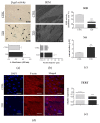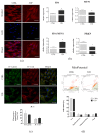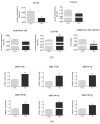Adipose-Derived Mesenchymal Stem Cells Isolated from Patients with Type 2 Diabetes Show Reduced "Stemness" through an Altered Secretome Profile, Impaired Anti-Oxidative Protection, and Mitochondrial Dynamics Deterioration
- PMID: 31151180
- PMCID: PMC6617220
- DOI: 10.3390/jcm8060765
Adipose-Derived Mesenchymal Stem Cells Isolated from Patients with Type 2 Diabetes Show Reduced "Stemness" through an Altered Secretome Profile, Impaired Anti-Oxidative Protection, and Mitochondrial Dynamics Deterioration
Abstract
The widespread epidemic of obesity and type 2 diabetes (T2D), suggests that both disorders are closely linked. Several pre-clinical and clinical studies have showed that adipose-derived mesenchymal stem cells (ASC) transplantation is efficient and safe. Moreover, scientists have already highlighted the therapeutic capacity of their secretomes. In this study, we used quantitative PCR, a flow cytometry-based system, the ELISA method, spectrophotometry, and confocal and scanning electron microscopy, to compare the differences in proliferation activity, viability, morphology, mitochondrial dynamics, mRNA and miRNA expression, as well as the secretory activity of ASCs derived from two donor groups-non-diabetic and T2D patients. We demonstrated that ASCs from T2D patients showed a reduced viability and a proliferative potential. Moreover, they exhibited mitochondrial dysfunction and senescence phenotype, due to excessive oxidative stress. Significant differences were observed in the expressions of miRNA involved in cell proliferations (miR-16-5p, miR-146a-5p, and miR-145-5p), as well as miRNA and genes responsible for glucose homeostasis and insulin sensitivity (miR-24-3p, 140-3p, miR-17-5p, SIRT1, HIF-1α, LIN28, FOXO1, and TGFβ). We have observed a similar correlation of miR-16-5p, miR-146a-5p, miR-24-3p, 140-3p, miR-17-5p, and miR-145-5p expression in extracellular vesicles fraction. Furthermore, we have shown that ASCT2D exhibited a lower VEGF, adiponectin, and CXCL-12 secretion, but showed an overproduction of leptin. We have shown that type 2 diabetes attenuated crucial functions of ASC, like proliferation, viability, and secretory activity, which highly reduced their therapeutic efficiency.
Keywords: adipose-derived mesenchymal stem cells; extracellular microvesicle; insulin resistance; regenerative medicine; type 2 diabetes.
Conflict of interest statement
Authors declare that there is no conflict of interest.
Figures





References
-
- World Health Organization . In: Global Report on Diabetes. Roglic G., editor. World Health Organization; Geneva, Switzerland: 2016.
-
- What is Diabetes? | NIDDK. [(accessed on 2 March 2019)]; Available online: https://www.niddk.nih.gov/health-information/diabetes/overview/what-is-d....
Grants and funding
LinkOut - more resources
Full Text Sources
Research Materials
Miscellaneous

